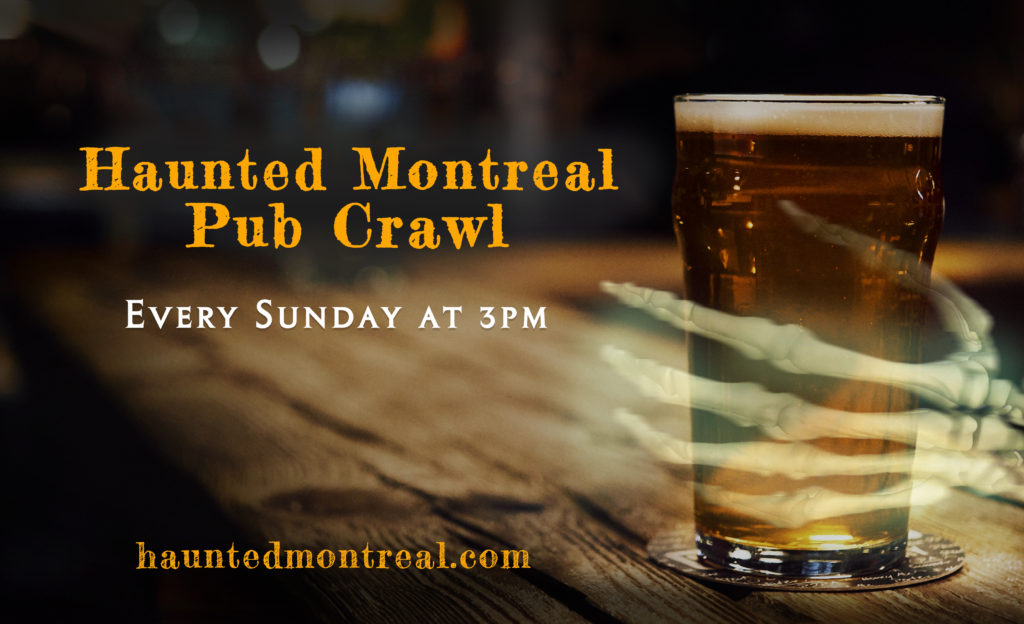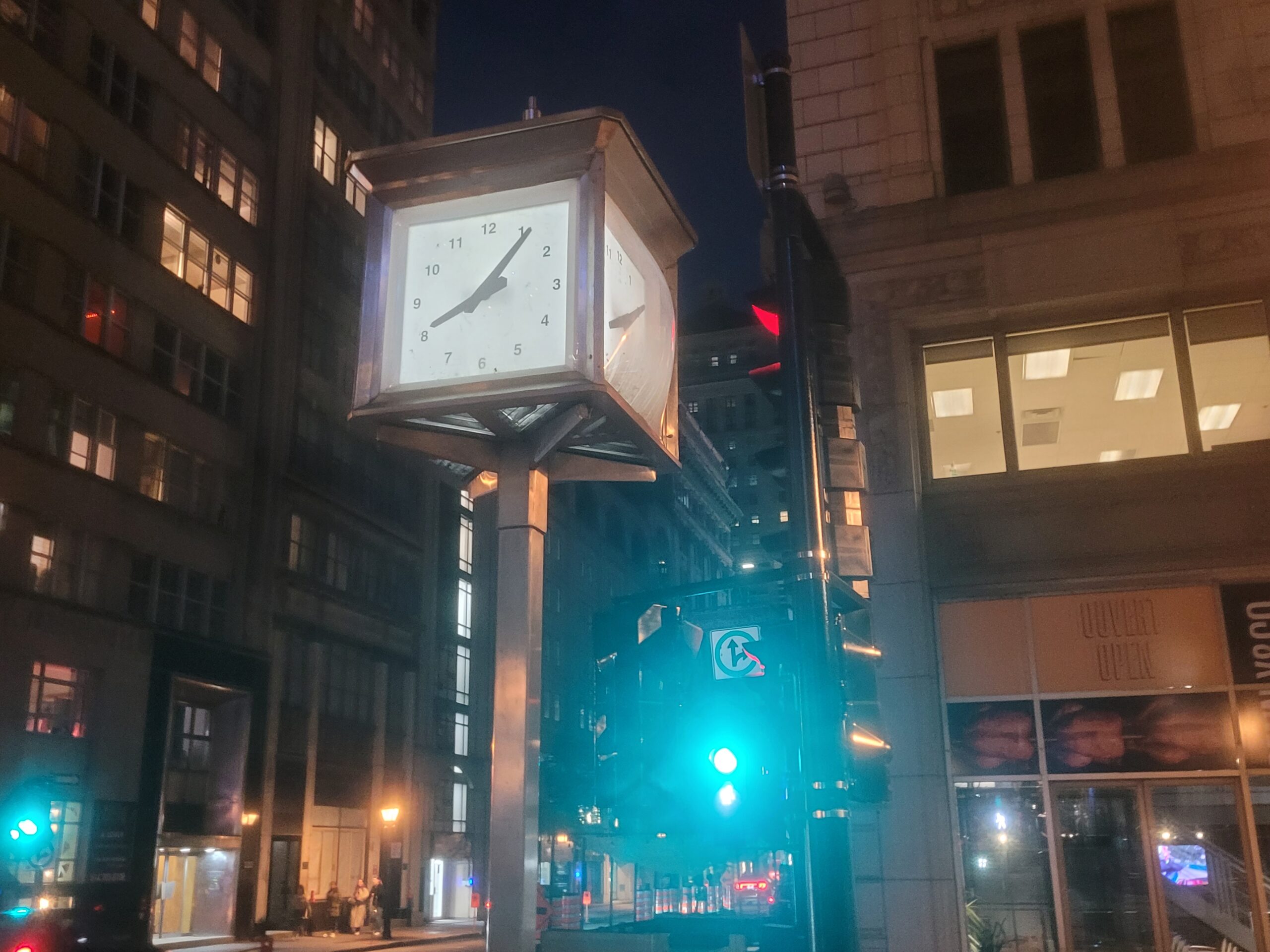While noted for their historical charm and timekeeping abilities, some of Montreal’s clocks are reputed to be haunted. Most of Montreal’s haunted clocks are located on St. James Street, an area associated with the extreme desecration of French colonial cemeteries by various financial corporations.
Welcome to the one hundred and second installment of the Haunted Montreal Blog!
With over 500 documented ghost stories, Montreal is easily the most haunted city in Canada, if not all of North America. Haunted Montreal dedicates itself to researching these paranormal tales, and the Haunted Montreal Blog unveils a newly researched Montreal ghost story on the 13th of every month!

This service is free and you can sign up to our mailing list (top, right-hand corner for desktops and at the bottom for mobile devices) if you wish to receive it every month on the 13th! The blog is published in both English and French!
With the winter upon us, our public tours are on pause until March, when the weather warms up. Our first outdoor tour is the special Irish Famine in Montreal Walk on Saturday, March 16 at 1 pm (in English)! Offered only twice per year, this tour delves into the ghosts of the Irish Famine in Montreal! On this walk we will also experiment with augmented reality to resurrect demolished and desecrated sites!
We also offer our Haunted Pub Crawl every Sunday at 3 pm in English. Tours in French happen on the last Sunday of every month at 4 pm.

Private tours for all of our experiences (including outdoor tours) can be booked at any time based on the availability of our actors. Clients can request any date, time, language and operating tour (except Haunted Mountain due to wintry conditions). These tours start at $215 for small groups of up to 7 people.
Email info@hauntedmontreal.com to book a private tour!

We also have an online store for those interested in gift certificates and company merchandise. More details are below in our Company News section!
This month we examine the Youville Stables in Old Montreal, a charming stone complex that hosts the famous Gibby’s Steakhouse. However, a ghost has been spotted in the courtyard reading a book – and he does not like to be disturbed!
Haunted Research
The Youville Stables is a charming stone complex in Old Montreal that was built on the hospital grounds of the Grey Nuns in 1827, originally as a warehouse. Today the site hosts the tony Gibby’s Restaurant, one of Montreal’s finest steakhouses. However, there are reports that its courtyard is haunted by an irate ghost who sits on a bench while reading a book. When approached, he tends to look up as though annoyed and proceeds to glare at those intruding his solitude – before disappearing into thin air.

While there have been several sightings of this ghost, the most prominent one was penned by Sonny Orr, a Cree writer and journalist from Chisasibi.
On February 10, 2010, he penned an article called “CREEEPY CCCANAADA…” for an Indigenous publication called The Nation.
In the article, he recounted two ghostly encounters, including one in the courtyard of the Youville Stables.

He explained:
“The first was at the popular Gibby’s restaurant in Montreal, where on a nice evening several years ago, we had a business supper and I brought my young daughter along. Since talking business wasn’t exactly her cup of tea (or milk), we decided to take a short break and check out the quaint ivy-covered courtyard. Holding hands, we noticed that a man holding a book was sitting on a bench further back.”
They did not want to disturb him, but as they circled the courtyard, they soon found themselves close to the man quietly reading on the bench.

Orr explained: “He slowly put down his book and looked at us, at first annoyingly then glaringly. He spoke volumes with his do-not-disturb attitude without saying a word. I, being naturally polite, stated that it was a nice evening to be out reading, but he didn’t respond, except by glaring even more sterner, so we walked away. Turning for a last look before going back into the restaurant, he was gone.”
Years later, after watching an episode of Creepy Canada about Old Montreal, Orr said “my neck hairs stiffened after realizing that what we had seen was a ghost.”

Orr isn’t the only one who has had a ghostly encounter at the Youville Stables. Indeed, the complex was once referred to as the “Phantom Stables” by Montreal’s now-banished calèche drivers. The site has a fascinating history.
The complex, made up of three solid stone warehouses, was constructed starting in 1826 for potash inspector Jean Bouthillier.

For twenty years, he had been doing his job in a wooden shed located on a large site that he rented from the Grey Nuns on a long-term lease.
That year, he and his then 32-year-old son Louis-Tancrède renewed the long-term lease. They planned to demolish the existing wooden structure and build a complex of three stone warehouses. Completed in 1828, the two warehouses to the east housed an ironworks yard and a nail factory, while the one to the west was used mainly for the Bouthilliers’ potash inspection business.

Built in the horseshoe shape of monastic complexes, the warehouses were built in the Neo-Classical tradition, with œil-de-bœuf windows, pediments and quoins. The cut-stone façade and large scale of the property reflected prosperity and solid construction methods for the era.
In the center, Jean Bouthillier created a quiet garden oasis within the horseshoe shape of the architecture. At the time, most gardens in what is today Old Montreal were off-limits to the less well-to-do. Private gardens at the time were seen as status symbols for powerful priests, wealthy citizens and influential merchants. As such, Jean Bouthillier saw his small courtyard as a private piece of paradise in an otherwise bustling urban area. It was a quiet and leafy place where he could relax, entertain guests and otherwise escape the hustle-bustle of the urban environment,

It was here that he enjoyed relaxing and holding deep conversations with his son, Louis-Tancrède. Jean Bouthillier encouraged him to pursue investment and educational opportunities. He explained to his son that he could move up the social ladder with hard effort, wise investments and solid social networking.
In 1832, Jean Bouthillier passed away. Louis-Tancrède was devastated, but he inherited a handsome sum, including 75% of the complex and property. The other 25% went to Pierre de Rastel de Rocheblave, his father’s brother-in-law.
Bouthillier used the rest of his inheritance to buy several properties in and around Montreal, including a farm at Côte Sainte-Catherine. The following year, he began to build a large, two-story brick house for his family on his newly-acquired farm. He named the property Outre-Mont, which means “the other side of the mountain” in English. He named it this given that his property was on the opposite side of Mount Royal from the City of Montreal. It was here, in his opulent home, that he would raise his two sons, Charles-Frontenac and Henri, along with his wife Françoise-Geneviève.

Louis-Tancrède continued to return to his garden oasis at the complex in Old Montreal on a regular basis. Recalling his father’s encouragement to aim high, he would often sit on a bench in the courtyard, studying business investments, famous literature and other writings.
Louis-Tancrède’s work paid off. In 1835, he was appointed Commissioner of the Lachine Canal, followed by Commissioner of Crown Lands in 1838.
When de Rocheblave sold his stake to Louis Renaud in 1850, Louis-Tancrède decided to rent the entire complex to him to serve his grain and provisions trade. Louis-Tancrède had become too busy moving up in the world to waste his time in the warehouse business.

In 1850, he assumed the role of the Customs Collector of Montreal. In 1863, Louis-Tancrède was appointed as the Sheriff of the city, a position he would hold for almost ten years. He also became the president of the Saint-Jean-Baptiste Society in 1864.
In 1875, Louis-Tancrède was honored when the area surrounding his home was recognized as a village and named Outremont, after the home he had built decades earlier. With only 300 inhabitants, Outremont would later grow into a very wealthy municipality for the city’s francophone elite.

Now retired, Louis-Tancrède Bouthillier could look back on a very successful career. Not only had he enjoyed some of the most important positions in the city, but his investments had made him a wealthy man. He had also raised a wonderful family. He often recalled his loving father and the magnificent time they spent together in the courtyard oasis between the stone complex of warehouses in Old Montreal.
Unfortunately, after a period of illness, Louis-Tancrède Bouthillier died in his home of Outre-Mont on February 28, 1881. The Saturday Budget announced:
“Mr. Louis-Tancrède Bouthillier, who formerly filled several public offices under the government, but long since retired from advanced years and infirmity, died here last evening at the age of 85. Among the offices which he held were Commissioner of Crown Lands, Collector of Customs and Sheriff of Montreal.”

Returning to the stone complex, the Grey Nuns decided to take over the administration of their property in 1869. Almost a century later, they sold the land and buildings to real estate developer Écuries D’Youville Limitée.
The company initiated a major restoration of the complex in 1967, under the direction of architect Janusz Warunklewicz. The project was rebranded “Écurie Youville / Youville Stables“, which was seen as odd because the property was never used to board horses or other animals.
Nevertheless, Gilbert (Gibby) Rosenberg was very impressed with the site and installed his second location of Gibby’s restaurant there in 1972.

He had opened the first location in St-Sauveur with two business partners in 1969. Serving high-end steak and seafood, Montreal Gazette food critic Lesley Chesterman described Gibby’s as “arguably Montreal’s most popular restaurant.”
Many people believe the ghost in the courtyard to be that of Louis-Tancrède Bouthillier, given his love of the garden oasis. There are many theories that ghosts sometimes return to the places they loved the most while alive.
However, some detractors think the ghost is none other than François Dollier de Casson, Montreal’s first historian.

On August 28, 2008, Norman Goldman published an article entitled “A Summer Walk into Montreal’s Early Years under French Rule” on a blog called BootsnAll: One Stop Indie Travel Guide. Goldman suggested:
“If you are in Montréal on a sunny weekend summer day and if you want to hear and perhaps see the ghosts of early Montréal, take a walk through “Vieux Montréal” (Old Montréal). The best time to embark on this venture is very early in the day on a Saturday or Sunday where you may encounter Monsieur Dollier de Casson Father Superior of the Seminaire de Montréal and perhaps Canada’s first town planner.”
François Dollier de Casson was a major figure in the early days of the Ville-Marie colony, as Montreal was formerly known. He was born in France into a wealthy bourgeois and military family in 1636. After serving in the French Army for three years, he decided to study to become a priest. Once accepted into the Sulpician Order, he was deployed to “New France”, an assignment he took on with some reluctance.

When he arrived in Quebec in 1666, his superiors appointed him as military chaplain to Prouville de Tracy, a commander carrying out a genocidal campaign against the Mohawk First Nation, whose territory the French were attempting to colonize.
Dollier de Casson was active as a missionary and explorer until becoming Superior of the Sulpicians in “New France” in 1671. He also contributed to church architecture, served as vicar general of the diocese of Quebec and ordered the first street survey of what is now Old Montreal.

He was also one of the key figures of the first attempt to dig the Lachine Canal, in 1689, which ultimately failed.
While Dollier de Casson was well known as a religious figure and public authority, he also appointed himself as the city’s first “historian” and wrote Histoire du Montréal, 1640-1672, Issues 1-5.
Furthermore, Dollier de Casson appears with a book in his hands in an official portrait, adding weight to the theory that he is the ghost in the courtyard.

Remarkably, Dollier de Casson also wrote about paranormal activities in the colony.
In one case, he described a “phantom ship” arriving in the city’s harbor on a misty day. The colonists could not agree whether it was a ship or not, and it later disappeared without having attempted any form of communication with the inhabitants of Ville-Marie. Another story involved a blood-stained handkerchief that could speak and even covert people to Catholicism!
Perhaps the most bizarre tale from Dollier de Casson is about a notary named Jean Saint-Père, whose decapitated head began harassing Oneida warriors after they had killed him.

In 1701, Dollier de Casson died at the age of 65 at the Montreal seminary. Those who suspect he is the ghost in the courtyard believe he loved the colony so much that he decided to stay after his death.
Whatever the case, both men suspected of being the ghost clearly loved the area that is today Old Montreal.
For those thinking of entering the courtyard of the Youville Stables, tread carefully. If anyone spots a man reading a book on one of the benches, it is best if he is left undisturbed!
Company News
Haunted Montreal is now in winter mode and is preparing for a whole new season!
Our first outdoor tour is the special Irish Famine in Montreal Walk on Saturday, March 16 at 1 pm (in English)! Offered only twice per year, this tour delves into the ghosts of the Irish Famine in Montreal! On this walk we will also experiment with augmented reality to resurrect demolished and desecrated sites of interest!

Our Haunted Pub Crawl is offered every Sunday at 3 pm in English. Tours in French happen on the last Sunday of every month at 4 pm.
Private tours for any of our experiences (including outdoor tours) can be booked at any time based on the availability of our actors. Clients can request any date, time, language and operating tour (except Haunted Mountain due to wintry conditions) These tours are based on the availability of our actors and start at $215 for small groups of up to 7 people.
Email info@hauntedmontreal.com to book a private tour!

You can also bring the Haunted Montreal experience to your office party, house, school or event by booking one of our Travelling Ghost Storytellers today. Hear some of the spookiest tales from our tours and our blog told by a professional actor and storyteller. You provide the venue, we provide the stories and storyteller. Find out more and then contact info@hauntedmontreal.com
Our team also releases videos every second Saturday, in both languages, of ghost stories from the Haunted Montreal Blog. Hosted by Holly Rhiannon (in English) and Dr. Mab (in French), this initiative is sure to please ghost story fans!

Please like, subscribe and hit the bell!
In other news, if you want to send someone a haunted experience as a gift, you certainly can! We are offering Haunted Montreal Gift Certificates through our website and redeemable via Eventbrite for any of our in-person or virtual events (no expiration date).
We also have an online store for those interested in Haunted Montreal merchandise for the holidays. We are selling t-shirts, magnets, sweatshirts (for those haunted fall and winter nights) and mugs with both the Haunted Montreal logo and our tour imagery.

Purchases can be ordered through our online store.
Haunted Montreal would like to thank all our clients who attended a ghost walk, haunted pub crawl, paranormal investigation or virtual event!
If you enjoyed the experience, we encourage you to write a review on our Tripadvisor page and/or Google Reviews, something that really helps Haunted Montreal to market its tours.

We are a small, specialized tourism company for fans of deranged history, ghost stories and the macabre and appreciate all the support and feedback we can get!
Lastly, if you would like to receive the Haunted Montreal Blog on the 13th of every month, please sign up to our mailing list.
Coming up on March 13: Auberge Saint Gabriel
The Auberge Saint-Gabriel is a quaint stone building in the heart of Old Montreal. Constructed in 1688 by a French soldier, the building would become the city’s first inn in 1754. Today, it hosts a fancy restaurant but is also reported to be haunted. From ghostly piano music to the spirit of a little girl who allegedly burned alive during a fire, the Auberge Saint-Gabriel is a well-known hotbed of paranormal activity.

Author:
Donovan King is a postcolonial historian, teacher, tour guide and professional actor. As the founder of Haunted Montreal, he combines his skills to create the best possible Montreal ghost stories, in both writing and theatrical performance. King holds a DEC (Professional Theatre Acting, John Abbott College), BFA (Drama-in-Education, Concordia), B.Ed (History and English Teaching, McGill), MFA (Theatre Studies, University of Calgary) and ACS (Montreal Tourist Guide, Institut de tourisme et d’hôtellerie du Québec). He is also a certified Montreal Destination Specialist.
Translator (into French):
Claude Chevalot holds a master’s degree in applied linguistics from McGill University. She is a writer, editor and translator. For more than 15 years, she has devoted herself almost exclusively to literary translation and to the translation of texts on current and contemporary art.




Comments (0)